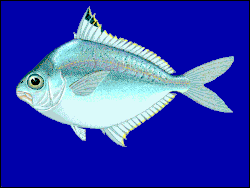Top Qs
Timeline
Chat
Perspective
Leiognathidae
Family of fishes From Wikipedia, the free encyclopedia
Remove ads
Leiognathidae, the ponyfishes, slipmouths or slimys / slimies, are a small family of fishes in the order Perciformes.[4] They inhabit marine and brackish waters in the Indian and West Pacific Oceans. They can be used in the preparation of bagoong.
Remove ads
Characteristics
Ponyfishes are small and laterally compressed in shape, with a bland, silvery colouration. They are distinguished by highly extensible mouths, and the presence of a mechanism for locking the spines in the dorsal and anal fins. They also possess a highly integrated light organ in their throats that houses symbiotic bioluminescent bacteria that project light through the animal's underside.[5][6][7] Typically, the harbored bacterium is only Photobacterium leiognathi, but in the two ponyfish species Photopectoralis panayensis and Photopectoralis bindus, Photobacterium mandapamensis is also present.[8] Two of the most widely studied uses for luminescence in ponyfish are camouflage by ventral counterillumination[9][10] and species-specific sexual dimorphism.[6][7][11][12] The light organ systems of ponyfishes are highly variable across species and often between sexes.[11][12]
Remove ads
Taxonomy
Leiognathidae is classified within the suborder Percoidei by the 5th edition of Fishes of the World, but they are placed in an unnamed clade which sits outside the superfamily Percoidea. This clade contains 7 families which appear to have some relationship to Acanthuroidei, Monodactylidae, and Priacanthidae.[13] Other authorities have placed the family in the order Chaetodontiformes alongside the family Chaetodontidae.[14]
Remove ads
Timeline of genera

Genera
The following genera are classified within the Leiognathidae, divided between two subfamilies based on Eschmeyer's Catalog of Fishes:[4][3][15]
- Family Leiognathidae Gill, 1893
- Subfamily Leiognathinae Gill, 1893
- Aurigequula Fowler, 1918
- Leiognathus Lacepède, 1802
- Subfamily Gazzinae Chakrabarty & Sparks, 2015
- Deveximentum Fowler, 1904 (previously as replacement name Secutor Gistel, 1848)
- Equulites Fowler, 1904
- Eubleekeria Fowler, 1904
- Gazza Rüppell, 1835
- Karalla Chakrabarty & Sparks, 2008
- Nuchequula Whitley, 1932
- Photolateralis Sparks & Chakrabarty, 2015[16]
- Photopectoralis Sparks, Dunlap & Smith, 2005
- Subfamily Leiognathinae Gill, 1893
The following fossil genera are also known:
- †Eoleiognathus Bannikov, 2014 (Early Eocene of Italy)[17]
- †Euleiognathus Yabumoto & Uyeno, 2011 (Middle Miocene of Japan)[18]
- †Leiognathoides Bannikov, 2001 (Early Oligocene to Early Miocene of Switzerland, Azerbaijan and North Caucasus, Russia)[19]
Remove ads
References
Wikiwand - on
Seamless Wikipedia browsing. On steroids.
Remove ads

